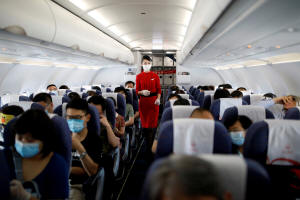Coronavirus exposure risk on airplanes very low, U.S. defense study
finds
 Send a link to a friend
Send a link to a friend
 [October 16, 2020]
By Tracy Rucinski and Sanjana Shivdas [October 16, 2020]
By Tracy Rucinski and Sanjana Shivdas
(Reuters) - The risk of exposure to the
coronavirus on flights is very low, a U.S. Department of Defense study
released on Thursday found, a positive sign for the airline industry as
it tries to rebound from the pandemic's crushing effect on travel.
When a seated passenger is wearing a mask, an average 0.003% of air
particles within the breathing zone around a person's head are
infectious, even when every seat is occupied, it found.
The testing assumed only one infected person on the plane and did not
simulate the effects of passenger movement around the cabin.
The study, conducted aboard United Airlines Boeing 777 and 767 aircraft,
showed that masks helped minimize exposure to infection when someone
coughed, even in neighboring seats.
About 99.99% of particles were filtered out of the cabin within 6
minutes due to fast air circulation, downward air ventilation and the
filtration systems on the aircraft.

It estimated that to receive an infectious dose, a passenger would need
to fly 54 hours on a plane with an infectious person.
United, which also provided pilots for the test, took pains to present
the results in its favor.
"These results ... mean your chances of COVID exposure on a United
aircraft are nearly non-existent, even if your flight is full," said
United Airlines Chief Customer Officer Toby Enqvist.
The study was led and funded by Transportation Command, which operates
Patriot Express flights that use commercial planes like United's for
members of the military and their families.
The research over six months involved 300 tests during 38 hours of
flight time and 45 hours of ground testing. It was done by releasing
particles the same size as the novel coronavirus across the entire cabin
by section, each of which had 42 sensors representing other passengers
who could potentially come in contact with the particles.
[to top of second column]
|

A flight attendant wearing a face mask and gloves following the
coronavirus disease (COVID-19) outbreak walks past passengers inside
a Sichuan Airlines aircraft before the flight takes off from Xichang
Qingshan Airport in Xichang, Sichuan province, China June 16, 2020.
REUTERS/Carlos Garcia Rawlins

Each test released 180 million particles – the number of particles
that would be produced by thousands of coughs.
Study participants included the Defense Advanced Research Projects
Agency (DARPA) and Boeing Co, among others.
Last week, plane manufacturers Boeing, Airbus SE and Embraer SA
released a joint publication showing that cabin air filters limit
the spread of viruses on their aircraft.
Their conclusions were based on computational fluid dynamics
research that simulated how particles move around the cabin.
The International Air Transport Association (IATA) said it has
identified only 44 flight-related COVID-19 cases since the beginning
of 2020 versus some 1.2 billion passengers who have traveled during
that time.
While "nothing is completely risk-free," the published cases of
potential inflight COVID-19 transmission show that "the risk of
contracting the virus on board appears to be in the same category as
being struck by lightning," IATA Director General Alexandre de
Juniac said.
(Reporting by Sanjana Shivdas in Bengaluru and Tracy Rucinski in
Chicago; Editing by Cynthia Osterman and Matthew Lewis)
[© 2020 Thomson Reuters. All rights
reserved.] Copyright 2020 Reuters. All rights reserved. This material may not be published,
broadcast, rewritten or redistributed.
Thompson Reuters is solely responsible for this content.
 |